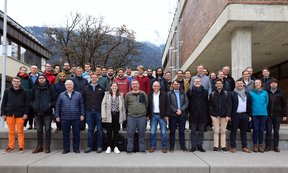Millenion will tackle the pressing challenges that quantum computers face on their path from the laboratory to industry scale. The successor to the EU Quantum-Flagship project AQTION the Millenion collaboration combines academic and industrial leaders across Europe. Leading science teams setting up the quantum computers based on trapped ions are joining forces with commercial leaders in the field of laser technology, optical design, cryogenic technology, control electronics and computer architectures, to realise the first scalable quantum computer that is capable of controlling 1000 qubits. The envisaged platform, which builds on top of the rack-mounted 50-qubit QC demonstrator realised in the flagship project AQTION, will offer a quantum advantage for various use-cases. “Our consortium will aggressively pursue disruptive development goals”, says Project Coordinator Dr. Thomas Monz, Senior Scientist at the University of Innsbruck and CEO of Alpine Quantum Technologies (AQT). “Changing from one-dimensional strings of ions to two-dimensional arrays will allow us to support up to 100 qubits and consistently encoding quantum information in the electronic ground state of ion qubits enables error rates smaller than 10-3 per gate operation compatible with fault-tolerant error correction. In addition, implementing parallel gate operations will enable larger algorithmic depth.”
The new demonstrator devices will be equipped with a hardware-optimised firmware suite and will be integrated in a high-performance computing (HPC) infrastructure to realise a QC/HPC solution, supporting standardised interfaces to various quantum software development kits with cloud accessibility. “Finally, we will pave the way to scalable quantum computing by introducing long-range connectivity between quantum processors”, is Thomas Monz confident. These quantum information techniques will be combined with trap fabrication and packaging technologies which integrate optical and electronic components to achieve stable long-term operation in an industrial environment. “These scientific and technological advances will provide a powerful hardware platform that can be exploited by partnering quantum software companies within this project, the ion-trap quantum computing platform will be extended to push towards 1000 qubits, realize fault-tolerant performance levels, and pursue the demonstration of a European quantum advantage”, says Thomas Monz as the project partners meet in Innsbruck, Austria, for the launch of the new project.

